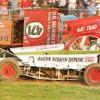-
Joined
-
Last visited
-
Days Won
178
Everything posted by Roy B
-
Ministox Final Top Three: 27 Luke Syrett-Barsby 425 Boden Murfin 20 Freddie H.Johnson
-
Final Focus: 263 leads away. From the get-go 55 is sliding wide in the corners. 132 takes the lead with 484 following at a distance. 263 spins it in turn 4. 191 is making inroads from the back. 555 whacks 175 into turn 3 but loses time himself. 132, 484, 73 and 392 are the equally spaced top 4 at this early stage. 2 eases 166 wide in turn 3. 515 does likewise a lap later. 73 up to 2nd by halfway. 84 cannons 191 into 484 approaching turn 3. Tom passes the 73 car in turn 1. 132 slides wide under pressure in turn 4 and sacrifices the lead spot to 392. At 5 to go 191 challenges 84 for 2nd and succeeds in taking the place. Coming to the chequered 132 slides wide in turn 4 and loses places. With a faultless drive Lewis takes the victory 👍
-
Final result: 392 84 2 515 73 16 484 25 166 132 259 Amended result. 191 disqualified after failing post-race checks. Thanks to 0S0 for the update 👍
-
Lewis Evans wins the Final 👍
-
The all-in Final grid: 263 132 484 392 73 25 175 8 555 2 191 259 166 55 16 515 84 568 starting at the back
-
Pit News: 55 - Both front brake calipers stripped down. 84 - Adjusting left rear lower link mounting point. 555 - Front left corner requires rework. JJ has donned the space-suit.
-
Heat Three Happenings: 132 leads away. 235 pulls off before the green. 415 spins it in turn 4. In the ensuing melee 242, 191, 2, and 555 end up in a heap. On a greasy track 55 slides wide through the turns. 242 rides up the side of 263 on the exit of turn 4. Red flag for the 195 rollover. 132 heads the restart. 73 eases 532 aside in turn 2 and takes the lead from 132 in turn 3. 55 throws it up the inside of 84 into turn 3 to take the position. At halfway Chris has 2 and 166 getting close. 515 is battling back through the field after being sent off line in the early going and latches onto the lead trio. The final two laps see 166 try for a bump and run move on 2 through turn 3 but the positions remain static. 73 takes the win.
-
Heat 3 result: 73 2 166 515 55 16 84 191 392 259 - 25 132 DNF: 235 415 555 175 242 195 501 8
-
Chris Cowley wins his second race of the day
-
Fence repairs complete 🤸♀️
-
Make that a lengthy delay
-
Whilst we wait here's a weather update. Steady rain driven by a 20mph southerly wind, and a temp of 7C. Positively tropical for High Edge 👍
-
Short delay for fence repair
-
Red flag for 195 who rolls over adjacent to the starter. All ok.
-
Complete restart
-
YF on lap 2 for 242 stranded on the exit of turn 4
-
Heat 3 grid: 'C' 132 263 'B' 195 532 415 392 235 501 'A' 73 25 175 242 8 Star 555 2 191 259 166 Superstar 55 16 515 84
-
The rain has arrived 🌧
-
Heat Two Happenings: 23 leads away. 515 hits 55 wide into turn 3 on lap 1. 502 and 484 follow suit the next time around. 73 is coming through rapidly from the back. 172 now leads. 259 is the next to have a pop at 55 into turn 3. At halfway 515 is closing on the lead duo. 191 gives 8 a whack into turn 3 at 4 to go. 73 takes the lead at 2 to go. 55 pushes 242 and 175 wide in turn 3. 242 then does the same to 175 at 1 to go. 172 tries to take the lead back from 73 entering the final turn as they come to the flag but ends up losing a couple of spots.
-
Heat 2 result: 73 515 84 172 25 16 191 166 2 8 - 55 555 DNF: 23, 484, 259
-
Chris Cowley wins Heat 2
-
Heat 2 grid: 'C' 23 'B' 502 484 172 'A' 73 25 175 242 8 Star 555 2 191 259 166 Superstar 55 16 515 84 568 starting from the back
-
Pit News: 235 - Porta power on the front right corner. 166 has arrived. 48 - Loading up. Diff blew after 4 laps in practice. An extra car has arrived - 55 Craig Finnikin.
-
Heat One Happenings: 132 leads away. 392 and 235 engage in battle behind, with 484 giving chase. 532 puts 235 hard into the turn 3 fence. 195 spins in avoidance. Caution to remove the two cars. 501 takes the lead on the restart. 392 and 132 have a side to side banging match down the back straight. 501 takes the win by half a straight.
-
Heat 1 result: 392 172 132 484 532 415 502 23 568 DNF: 263 195 235 Amended result. 501 disqualified after failing post-race checks. Thanks to 0S0 for the update 👍


